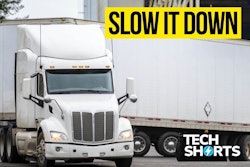Truckers have a tough ride handling hazardous cargo, semi-trailers, and 40-foot containers on highways — not to mention rural lanes. It’s about time we gave them a medal, don’t you think?
The connected truck market reached a grand $30.1 billion in 2023, and the industry predicts it will grow by a further $5 billion this year alone. The benefits of improved fuel efficiency, emission compliance, and fleet optimization have been widely discussed. But the humans behind the wheel, and the linchpins of logistics, have yet to have the spotlight they deserve.
We’ve seen the stats about driver shortages, the aging talent pool, and the lack of allure for the youngsters — it's no wonder when the other shouted data consists of trucker safety concerns. And then there are the upcoming restrictions on emissions standards for heavy-duty trucks covering model years 2027 through 2032. Given the current state of zero-emission technology, this means more responsibility falls on the driver.
However, some optimistic results seem to get brushed under the carpet: Drivers’ impressive truck handling, those operating at optimal in-motion and breaking speed, drivers with minimal idling, or fuel conservation champions who reduce fuel consumption per mile.
Companies need to look at the situation from a different perspective: maximizing connected trucks’ data to boost trucker morale and company performance simultaneously. Let’s get to it.
The power of data in driver management
It is estimated that advanced analytics will save truckers $168 billion by optimizing routes and enhancing fuel efficiency. Various data sources, from GPS to telematics, that display fuel consumption and driving behavior provide trucking companies with the insights they need to evaluate driver performance and reduce costs.
According to 2022 ISAAC research, driver behavior accounts for up to 30% of fuel costs. Based on over 40 parameters, including gear ratio and accelerator pedal pressure, analytics platforms can use telematics data to calculate potential fuel savings versus actual fuel usage. Trucking companies can build rewards programs that train truckers on how much pressure to apply to the throttle to maximize fuel efficiency, when to change gears, and whether or not to use cruise control on highways and interstates.
Identifying areas for improvement, such as harsh braking or excessive idling, is critical to ensure driver safety and cost-effective business performance. Recognizing positive driving habits like fuel efficiency and smooth driving is a motivational way to encourage truckers to keep doing what they do best.
Enhancing performance through positive reinforcement
Trucking companies will see positive outcomes when advocating for a data-driven approach focused on coaching and positive reinforcement rather than punishment. Personalized training programs based on individual driver data could empower drivers to improve their skills.
After three successful years, a North Carolina-based truckload carrier continues to make driver safety fun among its drivers with its March Madness challenge. The trucking company uses computer vision and AI to measure distracted driving and hard braking, improving driver safety scores. While the competition only lasts six weeks, once drivers realize the impact of their behavior, they are more likely to continue driving safely.
Trucking companies can make reward programs enjoyable with gamification elements, offering drivers points or tiered badges as they advance specific behaviors regarding fuel efficiency, speed, idling, and safety.
However, like any process change, employee acceptance comes with clear and open communication about how data usage and performance metrics will benefit those affected.
Ensuring fairness and driver buy-in
The constant tracking of location and activity can feel intrusive for truckers who are used to being trusted to do their job blindly. Where is that data going? Who’s accessing it? And what other purposes is it being used for?
Transparent data collection practices are critical to create a culture built on trust. Trucking companies must reassure drivers with the data security practices put in place, including authorization controls and anonymization methods to help them feel safe and protected.
Still, there are some situations where only drivers can protect themselves — like sudden breaking due to an unseen hazard. Does this mean the driver will be penalized for exceeding the gas threshold? No, we’re all only human — and cannot control the weather — so, some disruptions are inevitable, new processes or not. To manage expectations, make clear benchmarks and fair evaluation methods that consider factors beyond driver control, such as weather conditions and traffic congestion. We don’t want drivers prioritizing fuel consumption over their safety.
Ultimately, the best way to get drivers to buy in is to understand their thoughts. Ongoing driver feedback on data-driven performance measures creates more than a safe space for truckers to express their findings or concerns; it brings unique improvement strategies to the table from the driver's perspective.
The trucking industry has been feeling the squeeze on matching shipping demand with driver talent for a while now. It’s time to replace the headlines around labor shortages and truckers working overtime with our champion performers, arousing drivers with fun safety-first challenges and, most importantly, fair compensation.












